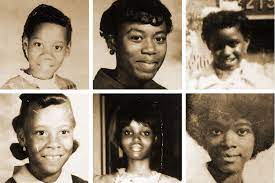The Mystery Of The 'Freeway Phantom'

In the early 1970s in Washington, DC, six young black girls were found dead within a year and a half. They were between the ages of 10 and 18. Each child had gone on a short errand, such as getting milk or going to the bus stop and never returned. Their bodies were found near the I-295 freeway several days later. All of the victims had been sexually assaulted and strangled to death, some with additional stab wounds and torture. All of the victims were missing their shoes except for 18-year-old Brenda Denise Woodard, whose shoes were personalized with her name and may have been too much of a liability to take.

The killer taunted families and law enforcement with clues. He called the police and told them where to locate the body of sixteen-year-old Darlenia Denise Johnson when he felt they were taking too long to locate her remains. He called the home of ten-year-old Brenda Faye Crockett, as well. The Freeway Phantom even made Brenda herself speak to her family in her final moments. He wanted to find out whether or not they'd seen him take her.
He left a note with the body of Brenda Woodard. It read:

Tragically, police never did catch the Freeway Phantom. There were, however, three major suspects:
A local gang known as the Green Vega Rapists came under suspicion for the serial murders of young black girls in the early 1970s in Washington D.C. Some members of the gang who were already incarcerated at Lorton Prison were among the first to be interviewed by the police. One member claimed to have information about the involvement of fellow gang members in the murders. It is unclear whether he was providing information in hopes of a lighter sentence, or if he was motivated by guilt.
Unfortunately, a local politician publicly revealed key details of the Lorton Prison interviews on the radio, and the witness immediately withdrew his cooperation for fear of being targeted by the gang. It is uncertain whether the information he provided was true or if he fabricated it for his own benefit.
Two Ex-Cops
Edward Sullivan and Tommie Simmons were the kind of bad apples that ruin the whole bunch. They resigned from the force during their probationary period, having served less than one year apiece. They did so in response to an incident in which their guns "went missing". Still, most reports identify them as "former police officers".
The two men were convicted of the rape and murder of Angela Denise Barnes. She was fourteen years old. Angela's age and race - and even her name - fit seamlessly among the other victims of the Freeway Phantom, and she was initially thought to be one of his victims. When Simmons and Sullivan were found guilty, investigators hoped they had found an answer to the Freeway Phantom killings entirely.
Unfortunately, authorities were never able to conclusively link Simmons and Sullivan to the other killings. Had the evidence been covered up by sympathetic police brethren? Or was the similarity to the other cases just a tragic coincidence?

Robert Askins
In the late 1970s, Robert Askins was charged with the rape and murder of a 24-year-old woman. As the police further investigated him, they discovered a disturbing pattern of criminal activity and a deep-seated hatred towards women. At the age of nineteen, Askins had used cyanide to poison five prostitutes at a brothel, resulting in the death of one. He also stabbed another prostitute to death just a couple of days later. As a result of these crimes, he was determined to be criminally insane and institutionalized for twelve years. Tragically, upon his release, Askins strangled yet another woman to death.
During the investigation of the Freeway Phantom murders, police searched Robert Askins' house and interviewed his colleagues but found only circumstantial evidence connecting him to the murders. The only notable piece of evidence was his frequent use of the word "tantamount". It is worth noting that the victims of Askins' known attacks were between the ages of 24 and 42, which is different from the age range of the victims of the Freeway Phantom, who were all children. This raises the question of whether Askins changed his victimology and then changed it back, or if there were two separate monsters operating in the same city.
Who do you think committed these atrocities? Will we ever know?

 My First News Item
My First News Item My Nine News Item
My Nine News Item